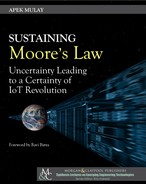78 11. THE INTERNET OF THINGS (IOT) REVOLUTION
Since the United States does not have free-market capitalism anymore, as it had in the
1950s–1970s, government intervention offers one way to stop the growth of Internet monopolies.
Hence, President Obama is absolutely correct in calling on the FCC to impose “the strongest pos-
sible rules” to protect net neutrality—prohibiting Internet service providers from favoring some
lawful content over others, and thus avoiding the creation of Internet industry monopolies that
would stagnate the growth of the IoT sector. It is possible to have minimal government inter-
vention in the economy and a self-regulation of the economy only by means of implementing a
free-market economic system. Free-market economic reforms would also result in an exponential
growth for the IoT sector. Letting employee wages automatically catch up with their productivity
would boost consumer demand in the economy.
Employee-owned corporations with a neo-cooperative management would also ensure that
all the people in an economy are real stakeholders of that economy, thereby establishing an eco-
nomic democracy. is new system would create plenty of jobs and put an end to the debate
about having only a few people pay taxes while the rest live on unemployment benefits. It would
also eliminate political corruption in the U.S. democracy, as majority shareholders of the cor-
porations (i.e., employees) would not allow passage of laws that would hurt their own interests.
An economic democracy would add value to the political democracy and make it a stakeholder
democracy, which would truly work as a government of the people, for the people, and by the
people. In this way, mass-capitalism-based reforms offer a free-market solution to achieve net
neutrality with minimal government intervention, through a smaller government, and with lower
taxes on individuals for success of the IoT revolution.
11.4 MASS CAPITALISM PAVES A PATH FOR THE IOT
REVOLUTION
e upcoming IoT revolution hopes to extend the end node far beyond the human-centric world
to encompass specialized devices with human-accessible interfaces, such as smart home ther-
mostats and blood pressure monitors, and even those that lack human interfaces altogether, in-
cluding industrial sensors, network-connected cameras, and traditional embedded systems. As the
IoT grows, the need for real-time scalability to handle dynamic traffic bursts also will increase.
Each of those IoT end nodes requires connectivity, processing and storage, some local, some in
the cloud. is means scalability, reliability, security, compliance, and application elasticity to
adapt to dynamic requirements and ever-changing workloads.
A three-tier business model would lead to an increase in consumer purchasing power in the
economy, thereby increasing the domestic consumer demand. Only when the consumer demand
rises through growth in wages, as compared to luring consumers into debt, can the economic
demand remain sustainable. When such free-market economic reforms become a reality in the
United States as well as global economy, it would lead to an increased demand for more IoT
products, like thousands of medical devices in hospitals, smart utility meters, GPS-based loca-

11.4. MASS CAPITALISM PAVES A PATH FOR THE IOT REVOLUTION 79
tion systems, fitness trackers, toll readers, motion detector security cameras, smoke detectors,
embedded systems, etc.
As shown in Figure 11.1 below, in order to ensure that the IoT revolution is sustainable and
leads to a balanced economic growth, where every end node on the Internet, private network, and
servers for central systems are able to connect to the private or public cloud, a three-tier business
model as presented in Chapter 5 is highly recommended. In this model, the upper industrial
tier would include the servers that need huge capital investments and constant upgrade, which
constitutes public and private clouds like Google Now, Amazon Web Services, etc. e middle
industrial tier (neo-cooperative corporations) includes the public and private broadband Internet
providers, networking service providers, computational service providers, and Big Data service
providers, as well as other software service providers. e lower industrial tier would be the small
businesses that can be connected via a network or be individually addressable networks (which
could be a LAN, PAN, body area network, etc.).
Figure 11.1: A three-tier business model for robust growth of the IoT sector.
Low unemployment is key to economic stability and robust growth of domestic consumer
demand. Only by means of establishing a true free-market economy, can consumer demand grow
..................Content has been hidden....................
You can't read the all page of ebook, please click here login for view all page.
